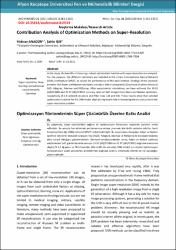| dc.contributor.author | Anagün, Yıldıray | |
| dc.contributor.author | Işık, Şahin | |
| dc.date.accessioned | 2023-09-07T10:21:23Z | |
| dc.date.available | 2023-09-07T10:21:23Z | |
| dc.date.issued | 31.12.2021 | en_US |
| dc.identifier.citation | Anagün, Y. & Işık, Ş. (2021). Contribution Analysis of Optimization Methods on Super-Resolution . Afyon Kocatepe Üniversitesi Fen Ve Mühendislik Bilimleri Dergisi , 21 (6) , 1343-1352 . DOI: 10.35414/akufemubid.819319 | en_US |
| dc.identifier.uri | https://dergipark.org.tr/tr/download/article-file/1373820 | |
| dc.identifier.uri | https://hdl.handle.net/11630/10785 | |
| dc.description.abstract | In this study, the benefits of choosing a robust optimization function with super resolution are analyzed. For this purpose, the different optimizers are included in the simple Convolutional Neural Network (CNN) architecture SRNET, to reveal the performance of the each method. Findings of this research provides that Adam and Nadam optimizers are robust when compared to (Stochastic Gradient Descent) SGD, Adagrad, Adamax and RMSprop. After experimental simulations, we have achieved the 35.91 (dB)/0.9960 and 35.97 (dB)/0.9961 accuracy rates on Set5 images from Adam and Nadam optimizers, respectively (9-1-5 network structure and filter sizes 128 and 64). These results show that selected optimization function for the CNN model plays an important role in increasing the accuracy rate in the super-resolution problem. | en_US |
| dc.description.abstract | Bu çalışmada, süper çözünürlükte sağlam bir optimizasyon fonksiyonu seçmenin yararları analiz edilmiştir. Bu amaçla her yöntemin performansını ortaya çıkarmak için farklı optimize ediciler, basit Evrişimsel Sinir Ağı (CNN) mimarisi SRNET' e dahil edilmiştir. Bu araştırmanın bulguları, Adam ve Nadam optimize edicilerin Stokastik Gradyan İnişi (SGD), Adagrad, Adamax ve RMSprop ile karşılaştırıldığında daha kararlı olduğunu göstermektedir. Deneysel simülasyonlardan sonra, Adam ve Nadam optimize edicilerinden Set5 görüntülerinde sırasıyla 35.91 (dB)/0.9960 ve 35.97 (dB)/0.9961 doğruluk oranlarına ulaştık (9-1-5 ağ yapısı ve filtre boyutları 128 ve 64). Bu sonuçlar, CNN modeli için seçilen optimizasyon fonksiyonunun süper çözünürlük probleminde doğruluk oranını arttırmada önemli bir rol oynadığını göstermektedir. | en_US |
| dc.language.iso | eng | en_US |
| dc.publisher | Afyon Kocatepe Üniversitesi | en_US |
| dc.identifier.doi | https://doi.org/10.35414/akufemubid.819319 | en_US |
| dc.rights | info:eu-repo/semantics/openAccess | en_US |
| dc.subject | Super-Resolution | en_US |
| dc.subject | Deep Learning | en_US |
| dc.subject | Convolutional Neural Network | en_US |
| dc.subject | Optimizer | en_US |
| dc.subject | Süper-Çözünürlük | en_US |
| dc.subject | Derin Öğrenme | en_US |
| dc.subject | Evrişimsel Sinir Ağı | en_US |
| dc.subject | Optimize Edici | en_US |
| dc.title | Contribution analysis of optimization methods on super-resolution | en_US |
| dc.title.alternative | Optimizasyon yöntemlerinin süper çözünürlük üzerine katkı analizi | en_US |
| dc.type | article | en_US |
| dc.relation.journal | Fen ve Mühendislik Bilimleri Dergisi | en_US |
| dc.department | Seçiniz | en_US |
| dc.authorid | 0000-0002-7743-0709 | en_US |
| dc.authorid | 0000-0003-1768-7104 | en_US |
| dc.identifier.volume | 21 | en_US |
| dc.identifier.startpage | 1343 | en_US |
| dc.identifier.endpage | 1352 | en_US |
| dc.identifier.issue | 6 | en_US |
| dc.relation.publicationcategory | Makale - Ulusal Hakemli Dergi - Başka Kurum Yazarı | en_US |



















